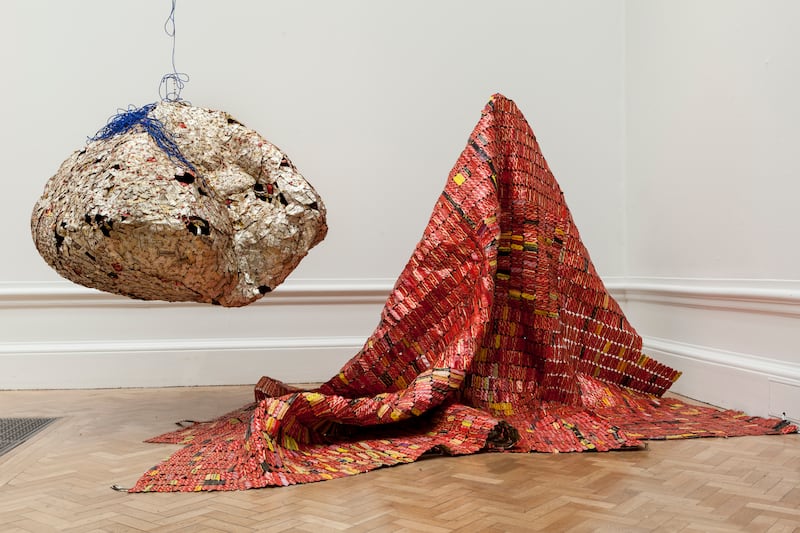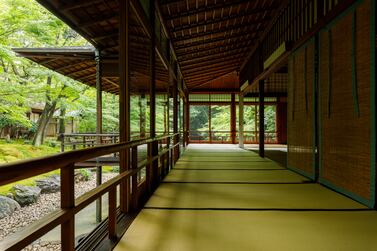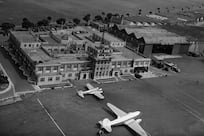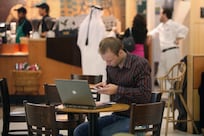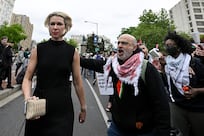Twelve public gardens in six countries will come together in September to stage one single show. How? Augmented reality.
As part of Seeing the Invisible, visitors download an app that will place the same works in front of them, whether they’re standing in the Royal Botanic Gardens in Edinburgh or the Tucson Botanical Gardens in Arizona.
Veteran Emirati artist Mohammed Kazem will be one of the dozen artists participating in this new venture, alongside major artists such as Ai Weiwei from China, Ghanaian sculptor El Anatsui and British video artist Isaac Julien.
“Coming out of the pandemic when outdoor experiences and nature have taken on a new meaning and gravity in our lives, this exhibition represents a fresh way for people to engage with art and nature simultaneously,” says the exhibition’s co-curator Tal Michael Haring.
![DUBAI, UNITED ARAB EMIRATES - SEPTEMBER 27, 2018.
Mohammed Kazem infront of his series "Even the Shade does not Belong to Them" at his solo show "A Prime Activity", in Gallery Isabelle van den Eynde.
The show focuses on his paintings – a relatively unknown aspect of his practice. Kazem has been painting since his late teens and early 20s, went on to win the first prize in painting at Muscat Youth Biennial in 1990 and loved the surface so much that he remained consciously aware to the inspiration coming from the medium itself.
While painting remained a major aspect of Kazem’s early practice, now more than 30 years later, he is still fascinated by collecting and documenting information about unimportant objects and traces of our present within a particular environment. In his monograph published in 2013, Hassan Sharif wrote, “The meaning or purpose of his [Kazem’s] paintings lies in the life of the colours and the ways they can be put to use, not in the painted objects themselves.”
(Photo by Reem Mohammed/The National)
Reporter: Melissa Gronlund
Section: AC](https://thenational-the-national-prod.cdn.arcpublishing.com/resizer/v2/YMW4ODK5Z6YZTVAX4WRNITALTI.jpg?smart=true&auth=fa77454f300cbe6a1ad854e0108c0de205d9bb857ec9453d97e59593328a370b&width=400&height=266)
“The interplay of these augmented reality works in vibrant natural settings breaks down the binary between what is often considered ‘natural’ versus ‘digital’, and in this way provides an exhibition experience that is much more connected to the way we live today.”
Seeing the Invisible was co-curated by Haring with Hadas Maor, both from Israel, and takes advance of AR technology to allow the artists to create the same installations in vastly different climates.
The show also points to botanical gardens as fascinating subjects in themselves; they became fashionable during European colonialism, and often host microcosms of biomes transplanted from elsewhere in the world – making them transnational entities in themselves.
The curators believe that the dislocation involved in seeing tropical plants in Cornwall, for example, will probably be deepened by the experience of seeing the virtual artworks across the global venues.
“There is exceptional potential for botanical gardens, with their deep expertise in engaging diverse audiences in their complex work, to lead the way in creating new models for visitor experiences of contemporary art,” says Hannah Rendell, executive director of the Jerusalem Botanical Gardens, which initiated the project with the UK organisation Outset Contemporary Art Fund.
Many of the artists have worked extensively to explore the borderlines between the digital and physical words, such as Pamela Rosenkranz and Timur Si-Qin. The technology is new for others, but many of the artists take globalism as a starting point.
Kazem, for example, is best known for his paintings and to a lesser extent his installations, both of which approach the world around him with a keen power of observation. El Anatsui, who lives in Nigeria, repurposes bits of metal packaging to create spectacular shimmering pieces of cloth that combine craft traditions with the geographic trajectory of consumer items that travel across the globe. Ai also investigates how objects accrue meaning, from one-off items to commodities, and how this status shifts in context in different locales.
It’s unclear whether the botanic gardens emphasise the continuity among their settings or the variations in their geographies, which are widely spread.
Participating venues include the Eden Project in Cornwall, the Kirstenbosch National Botanical Garden in Cape Town, the Massachusetts Horticultural Society and the Royal Botanic Gardens Victoria in Melbourne. What the artwork does in all these spaces is yet to be seen.
Seeing the Invisible is on view from September until August 2022. More information is available at seeingtheinvisible.art
